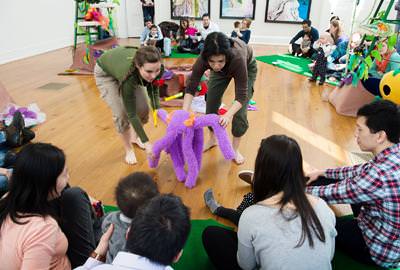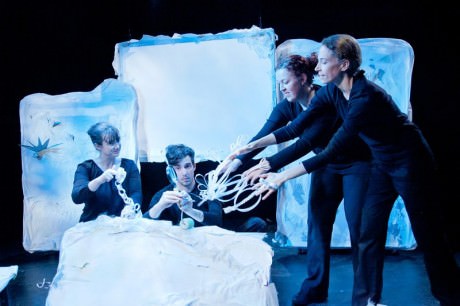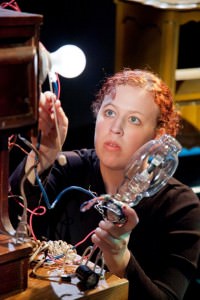Arts on the Horizon presents Under the Canopy, an engaging sensory experience especially envisioned for children ages 0-2. Created and directed by Matt Bassett and Tia Shearer Bassett, this playful production is a perfect way to introduce your child to the world of live entertainment, and maybe make some new friends in the process!

The setting for this show is an informal and interactive one; inspired by the rainforest, a trio of green ladders are covered with tropical felt flowers and vines, and surrounded by cushy mats for families to sit on. Each mat comes with a few scraps of textured fabric and egg-shaped rattles to keep the children entertained while waiting for the show to begin. A speaker begins to play soft rainforest sounds in the background, and performers Jessica Lefkow and Teresa Spencer take to the floor.
The plot is fairly straightforward (an afternoon in the rainforest) and the actors perform it with great enthusiasm. Dressed in casual clothes with felt birds and flowers pinned to them, they make their way around the circle, greeting the children with big smiles, but no words. Jessica and Teresa have put themselves on the same level as their audience, and while they coo, squeal, and whoop with sounds of awe and excitement, they do not speak. They use cushy hand puppets designed by Wits End Puppets alongside a variety of cloths and fabrics to play out scenes such as a caterpillar transforming into a butterfly, a bird making its nest, and a vine that turns into a snake!
Though the show is a nonverbal one, that does not mean that it is quiet! The actors use a wide variety of props like rain sticks, wooden blocks, and other small instruments to ensure that the children are introduced to many different sounds, as well as what those different sounds may belong to, such as whistles for birds and kazoos for insects. The children loved it! Some even had to be kept from jumping up and joining in on the action!
What I enjoyed most about this production was after the “show” was over, and they invited everyone to hop off their mats and play with the very same props that they had been watching for the past 20 minutes (the perfect amount of time for such a young audience). The set of the production really just turned into one big, colorful playground. As I left, I saw a lot of kids playing together and making new friends.

Under the Canopy is one giant playdate, and is a perfect way to meet new families with children of similar ages. Not only your child, but perhaps you as well, are given a great opportunity to make some new friends in your area through this experience. As a parting gift, each family was given a couple of fabric swatches (one threaded, one fuzzy) and a texture “treasure hunt” to continue the sensory experience at home. Make this show, or a future Arts on the Horizon production, a part of a fun afternoon in Old Town Alexandria!
Running Time: Approximately 20 minutes.
Under the Canopy plays through October 5, 2014 at The Athenaeum– 201 Prince Street, in Alexandria, VA. All online sales for this production are sold out, but a limited number of tickets are available at the door on the day of each sold-out performance. See details here.




